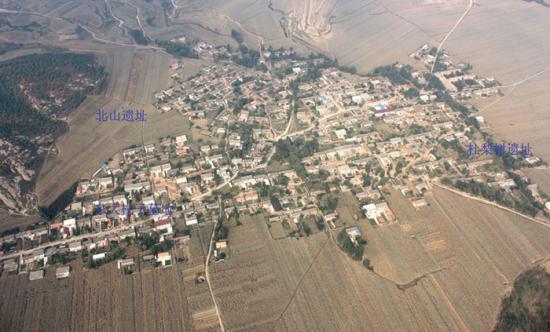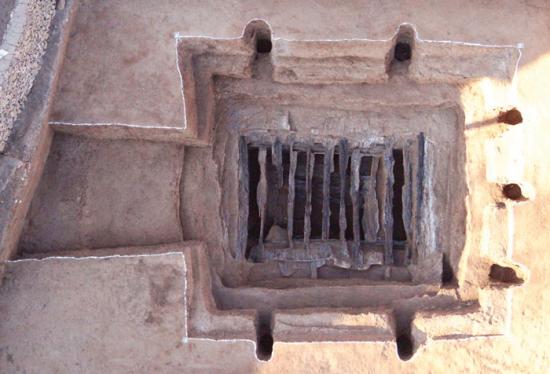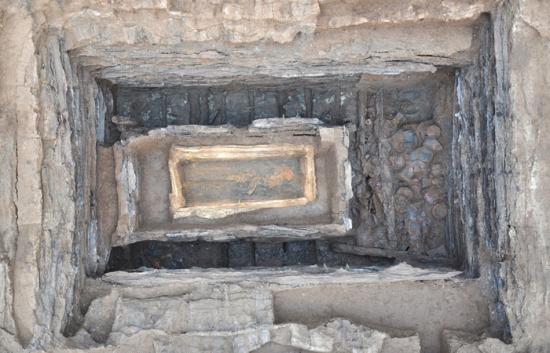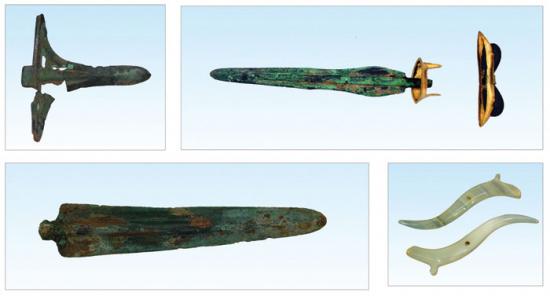The Warring States Cemetery in Jianchang Dongdazhangzi of Liaoning Province
Chinese Institute of Archaeology
Source - http://www.kaogu.cn/en/detail.asp?ProductID=3417
Dongdazhangzi cemetery is situated at the Dongdazhangzi village, Jianchang county, Liaoning province. For the purpose of the understanding and protection for the cemetery, three-level cultural relic departments, i.e., Liaoning province, Huludao city, and Jianchang county, collaborated and conducted initially archeological investigations and preliminary excavations in 2000. Consequently, for being fitting the needs of basic constructions, numerous salvaging excavations were conducted on this site, where a total of forty-three tombs were cleaned up. The excavations led to a result of the significance of this cemetery, while the general layout and scale are still unclear. The archaeologists have no idea how the cemetery related to its adjacent contemporary sites like Beishan and Dulishu. Besides, it is difficult for its preservation, for being robbed for many times. Liaoning provincial institute of archaeology and cultural relic made a five-year plan for the future archaeological work in Dongdazhangzi cemetery as well as its site in 2010

Since May, 2011, based on the archaeological plan that has been done, Liaoning provincial institute of archaeology and cultural relic and other units have conducted comprehensive, systematic archaeological investigations on the cemetery and its adjacent site. Meanwhile, detailed surveying and mapping were done concerning on its neighboring topography and geomorphology. With the evidence of surveys and investigations, the cemetery area is located in a village, west to the previous watercourse in the middle of the Dongdazhangzi village, with an area of more than 100,000 square m. The cemetery consisted of a hundred and thirty-seven individual tombs found in the open area of courtyard and places among roads. There were a variety of remains found at Beishan site, northwest to the mortuary area, including kilns, ash pits, trenches and kitchen range remains and etc. The Dulishu site, located five hundred meter east to the cemetery area, may have been used as kiln during the times from the Warring States to Western Han periods.
With the evidence of investigations and preliminary excavations, we have begun to understand the Dongdazhangzi cemetery. Oriented mostly from the west to east, there has been no certain clue how the tombs were ordered. In terms of their size, there were three burial types, i.e., large-, middle-, and small-sized tombs. The length of the tombs varies: large tombs had seven to nine meter long, six to eight meter wide; middle-sized graves three to five meter long, two to four meter wide; small-sized graves two to three meter long, 1.2 to 2 meter wide. Large-sized graves were mostly concentrated in the center and to the south of the cemetery area, opposed to the other burial types. The middle- and small-sized graves were distributed surrounding or among the larger ones. All of the tombs were consisted of earth shaft pit and wooden coffin. Two types have been identified: one filled with earth, one covered with stone. As for stone-covered tombs, bigger pebbles usually were placed between the pit opening and secondary platform in, and usually middle to small in size, accompanying with abundant grave goods. Most of the earth pit tombs had small size, accompanying with a smaller quantity of grave goods, mostly ceramics. M40, an earth pit tomb, was excavated in 2011 and had a larger size. Here human bones were mostly eroded and finally disappeared. With the evidence of teeth, locus of femur traces retrieved from a smaller quantity of burials, the grave, headed to the east, contained one dead person, lying straightly in supine position. The burial offerings were mostly placed in the eastern part of the coffin, with a smaller amount of items found in the western and middle parts.

1. Large-sized tombs: M40, for example.
The tomb structure, in a shape of ‘凸’ , had its southern and northern walls, 9 meter long and eastern and western walls 8 meter wide. The excavations have revealed a total of seven column grooves in the walls to the east, south and north, in the form of half oral. The tomb passage went to the west, with its trapezoidal section, and have a slopping steps connected to burial pit. The tomb walls, corrugated, had second-tiered and third-tiered platforms of raw soil, which going downwards and slopping till the bottom of the earth pit. The tomb walls and steps were partly plastered with limestone powder mixed with white pebbles and fine yellowish clay. Along the tomb bottom were two outer coffins and one inner coffin: base, walls and top of the outer coffin were built of large wooden blocks, which measured five meter long from the east to west, 2.7 m wide from the south to north and remaining 1.45-2.2 m in height. The area between coffins and pit walls were filled with earth, leading to the forth-tiered platform of deposition. Inner coffin was located in the center of the outer coffin, slightly to the west, 3.2 m long, 1.6 m wide and 1.3 m high, decorated with four columns in the four corners. The coffin was placed in the middle of the inner coffin, in the shape of trapezoidal. It measured two meter from the south to the north, 0.8-1.04 m wide and 0.4 meter high. The skeleton was not well preserved, with barely eroded sections of teeth. The dead person was headed to the east.
Burial offerings were often found in head box between inner and outer coffins, mainly including painted ceramics imitating bronze for a ritual use, such as Ding tripod, Dou stemmed cup, pots and plates etc. about dozens in number and large in size. Animal decorations were bright-colored and applied distinctly. In addition, well-made talcum hollowed ornaments and ceramic beads and etc. were frequently found on the board of outer coffin base. Talcum hollowed ornaments could be divided into two categories: one like ring, decorated with three to four hooked cloud motives. The other is rectangular, decorated with a pair of two-bodied serpentine design. The burial goods found within the coffins contained bronze hooks for the clothes, ring-headed knives, carnelian rings, turquoise beads and etc. To the east adjacent to the second-tiered platform lay a great amount of animal bones in the center, including horses, oxen, sheep/goats, pigs, and dogs, a total of seventy-four individuals. A wooden box was found to the west of heaps of animal bones. In the box were ceramic ornaments and others precious stones.

2. Middle-sized graves: M4, for example.
Stone-covered burials, covered with paved large pebbles, four meter long, 3.4 meter wide, and 1.3 meter deep. The distance between the burial base and ground above is 3.2 meter. There were second-tiered and third-tiered platforms located between wooden coffin and grave wall, of which the animal teeth were placed on top of second-tiered platforms to the east. Burial consisted of an inner coffin and outer one, with the head box found in the east. The outer coffin measured 3.08 m long and 1, 15 meter wide. The coffin oriented 80 degree, 2.5 m long and 0.95 m wide. Ten tiebeam remains are still existed at the opening of the outer coffin, which could be parts of the covering slab of the coffin. The skeleton had been rotten and not exited again. Bronze vessels, such as Dou vessel with lid, carnelian cup, beads ornament, jade disk and weapons such as daggers, spears, axes, and arrowheads were found at the position of skeleton of head, abdomens, body side and beneath the feet separately. Bronzes for the purpose of ritual, such as pot, Ding tripod, xi vessels and items of vehicles and horses, such as gag bits, as well as lacquer wares were found in the head box. Among them, the bronze dagger with golden handle, which has been the second time most important discovery since that of M14, are especially precious.
3.Small-sized graves: M13, for example; a stone-covered tomb, with its pit measuring 2.6 m long, 1.4 m wide and ca. 0.8 m deep; coffin 2.1 m long, 0.6 m wide and remaining height of 0.35~0.4 m. Within the filled earth in the southeastern part of the earth pit were five cow heads. Accompanying burial goods within the coffin were bronze axes, spears, razors, hooks for garments, house bits, and gag bits; ceramic jars, Dou vessels with lids, tassels and other ornaments, more than twenty. Small-sized earth-filled tombs contained a smaller quantity of burial goods and most of them are pottery.

The excavations of forty-three tombs yield nearly thousands of burial goods, among which characteristic items include bronze daggers attached with golden handle and inlaid frame, double-blade daggers, connected pots, painted ceramic vessels for ritual purpose imitating bronze, ceramic jars with short-necked low-belly, bowl-shaped plate style ceramic Dou vessel with heavy stems, He vessels with a spout attached to a side, large open-mouthed jars. Many of these items could be taken as the magnificent archaeological discovery in the northeastern region of Bronze Age for the first time.
With the evidence of the items with central plain character and the burial types, most of the tombs could be dated to the middle-late Warring States period. Therefore, the entire cemetery should have been built from the middle Warring States to initial period of Han dynasty. The excavations have revealed the cultural content, providing the significant value for the study of the minority national cultures and their connection with central plain. Firstly, northeastern bronze daggers can be taken as one of the most typical items of the archaeological cultures in Liaoning, and even in the Northeastern Asia area during the late Bronze Times. But, due to the scattered archaeological records, there has been no evidence of such tombs previously like Dongdazhangzi, in which archeologists found large cemetery containing a large quantity of burial goods, especially the daggers with golden handle. This evidence would provide the significance for the discussion on the origins, interacts, and activity centers of different periods which people using this kind of bronze daggers. Secondly, the place, where the cemetery located, controlled by Right Beiping county of Yan State during the late Warring States. Due to the rarity of related archaeological material, the location of it municipal court are still mystery. The discovery of the high-ranked burial (M40)unearthed in Dongdazhangzi provided a valuable clue for the interpretation of this problem. Meanwhile, these field works indicate that a part of the Northeastern area may have belonged to the territory of Yan, supporting the central power for the establishment of county-town administration as well as effective control in the Northeastern area during Qin-han periods.
(Translator: Sang Li)